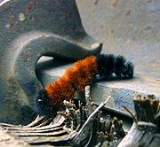
Caterpillar
Overview
Caterpillars are the larva
l form of members of the order
Lepidoptera
(the insect
order comprising butterflies
and moth
s). They are mostly herbivorous
in food habit, although some species are insectivorous
. Caterpillars are voracious feeders and many of them are considered to be pests in agriculture
. Many moth species
are better known in their caterpillar stages because of the damage they cause to fruits and other agricultural produce.
The etymological origins of the word are from the early 16th century, from Middle English
catirpel, catirpeller, probably an alteration of Old North French
catepelose: cate, cat (from Latin cattus) + pelose, hairy (from Latin pilōsus).
The geometrids, also known as inchworms or loopers, are so named because of the way they move, appearing to measure the earth (the word geometrid means earth-measurer in Greek
); the primary reason for this unusual locomotion is the elimination of nearly all the prolegs except the clasper on the terminal segment.
Caterpillars have soft bodies that can grow rapidly between moults.
Larva
A larva is a distinct juvenile form many animals undergo before metamorphosis into adults. Animals with indirect development such as insects, amphibians, or cnidarians typically have a larval phase of their life cycle...
l form of members of the order
Order (biology)
In scientific classification used in biology, the order is# a taxonomic rank used in the classification of organisms. Other well-known ranks are life, domain, kingdom, phylum, class, family, genus, and species, with order fitting in between class and family...
Lepidoptera
Lepidoptera
Lepidoptera is a large order of insects that includes moths and butterflies . It is one of the most widespread and widely recognizable insect orders in the world, encompassing moths and the three superfamilies of butterflies, skipper butterflies, and moth-butterflies...
(the insect
Insect
Insects are a class of living creatures within the arthropods that have a chitinous exoskeleton, a three-part body , three pairs of jointed legs, compound eyes, and two antennae...
order comprising butterflies
Butterfly
A butterfly is a mainly day-flying insect of the order Lepidoptera, which includes the butterflies and moths. Like other holometabolous insects, the butterfly's life cycle consists of four parts: egg, larva, pupa and adult. Most species are diurnal. Butterflies have large, often brightly coloured...
and moth
Moth
A moth is an insect closely related to the butterfly, both being of the order Lepidoptera. Moths form the majority of this order; there are thought to be 150,000 to 250,000 different species of moth , with thousands of species yet to be described...
s). They are mostly herbivorous
Herbivore
Herbivores are organisms that are anatomically and physiologically adapted to eat plant-based foods. Herbivory is a form of consumption in which an organism principally eats autotrophs such as plants, algae and photosynthesizing bacteria. More generally, organisms that feed on autotrophs in...
in food habit, although some species are insectivorous
Insectivore
An insectivore is a type of carnivore with a diet that consists chiefly of insects and similar small creatures. An alternate term is entomophage, which also refers to the human practice of eating insects....
. Caterpillars are voracious feeders and many of them are considered to be pests in agriculture
Agriculture
Agriculture is the cultivation of animals, plants, fungi and other life forms for food, fiber, and other products used to sustain life. Agriculture was the key implement in the rise of sedentary human civilization, whereby farming of domesticated species created food surpluses that nurtured the...
. Many moth species
Species
In biology, a species is one of the basic units of biological classification and a taxonomic rank. A species is often defined as a group of organisms capable of interbreeding and producing fertile offspring. While in many cases this definition is adequate, more precise or differing measures are...
are better known in their caterpillar stages because of the damage they cause to fruits and other agricultural produce.
The etymological origins of the word are from the early 16th century, from Middle English
Middle English
Middle English is the stage in the history of the English language during the High and Late Middle Ages, or roughly during the four centuries between the late 11th and the late 15th century....
catirpel, catirpeller, probably an alteration of Old North French
Old French
Old French was the Romance dialect continuum spoken in territories that span roughly the northern half of modern France and parts of modern Belgium and Switzerland from the 9th century to the 14th century...
catepelose: cate, cat (from Latin cattus) + pelose, hairy (from Latin pilōsus).
The geometrids, also known as inchworms or loopers, are so named because of the way they move, appearing to measure the earth (the word geometrid means earth-measurer in Greek
Greek language
Greek is an independent branch of the Indo-European family of languages. Native to the southern Balkans, it has the longest documented history of any Indo-European language, spanning 34 centuries of written records. Its writing system has been the Greek alphabet for the majority of its history;...
); the primary reason for this unusual locomotion is the elimination of nearly all the prolegs except the clasper on the terminal segment.
Caterpillars have soft bodies that can grow rapidly between moults.
Unanswered Questions
Discussions

